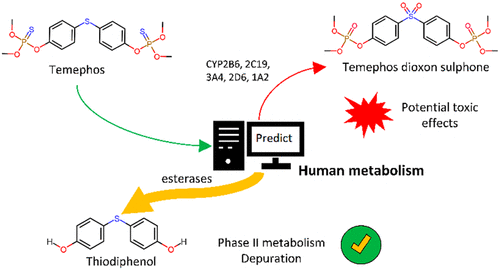当前位置:
X-MOL 学术
›
Chem. Res. Toxicol.
›
论文详情
Our official English website, www.x-mol.net, welcomes your
feedback! (Note: you will need to create a separate account there.)
Human Biotransformation Pathway of Temephos Using an In Silico Approach
Chemical Research in Toxicology ( IF 3.7 ) Pub Date : 2020-10-28 , DOI: 10.1021/acs.chemrestox.0c00105 Andrés Reyes-Chaparro 1 , Francisco Alberto Verdín-Betancourt 1 , Adolfo Sierra-Santoyo 1
Chemical Research in Toxicology ( IF 3.7 ) Pub Date : 2020-10-28 , DOI: 10.1021/acs.chemrestox.0c00105 Andrés Reyes-Chaparro 1 , Francisco Alberto Verdín-Betancourt 1 , Adolfo Sierra-Santoyo 1
Affiliation

|
Temephos is an organophosphorothioate (OPT) larvicide used for controlling vectors of diseases such as dengue, chikungunya, and Zika. OPTs require a metabolic activation mediated by cytochrome P540 (CYP) to cause toxic effects, such as acetylcholinesterase (AChE) activity inhibition. There is no information about temephos biotransformation in humans, and it is considered to have low toxicity in mammals. Recent studies have reported that temephos-oxidized derivatives cause AChE inhibition. The aim of this study was to propose the human biotransformation pathway of temephos using in silico tools. The metabolic pathway was proposed using the MetaUltra program of MultiCase software as well as the Way2Drug and Xenosite web servers. The results show the following three essential reactions of phase I metabolism: (1) S-oxidation, (2) oxidative desulfurization, and (3) dephosphorylation, as well as the formation of 19 possible intermediary metabolites. Temephos dephosphorylation is the most likely reaction, and it enables phase II metabolism for glucuronidation to be excreted. However, the CYP-dependent metabolism showed that temephos oxon can be formed, which could lead to toxic effects in mammals. CYP2B6, 2C9, and 2C19 are the main isoforms involved in temephos metabolism, and CYP3A4 and 2D6 have minor contributions. According to computational predictions, the highest probability of temephos metabolism is dephosphorylation and phase II reactions that do not produce cholinergic toxic effects; nonetheless, the participation of CYPs is highly possible if the primary reaction is depleted.
中文翻译:

使用 In Silico 方法的 Temephos 人类生物转化途径
Temephos 是一种有机硫代磷酸酯 (OPT) 杀幼虫剂,用于控制登革热、基孔肯雅热和寨卡病毒等疾病的传播媒介。OPT 需要由细胞色素 P540 (CYP) 介导的代谢激活才能引起毒性作用,例如乙酰胆碱酯酶 (AChE) 活性抑制。没有关于 temephos 在人类中生物转化的信息,并且认为它在哺乳动物中具有低毒性。最近的研究报告称,替美磷氧化衍生物会导致 AChE 抑制。本研究的目的是提出使用计算机工具的 temephos 人类生物转化途径。代谢途径是使用 MultiCase 软件的 MetaUltra 程序以及 Way2Drug 和 Xenosite 网络服务器提出的。结果显示 I 相代谢的以下三个基本反应:(1)S-氧化、(2) 氧化脱硫和 (3) 脱磷酸,以及 19 种可能的中间代谢物的形成。Temephos 去磷酸化是最可能的反应,它使用于葡萄糖醛酸化的 II 相代谢得以排出。然而,CYP 依赖性代谢表明可以形成 temephos oxon,这可能导致哺乳动物的毒性作用。CYP2B6、2C9 和 2C19 是参与 temephos 代谢的主要同种型,CYP3A4 和 2D6 的贡献较小。根据计算预测,temephos 代谢的最高概率是去磷酸化和不产生胆碱能毒性作用的 II 相反应;尽管如此,如果主要反应耗尽,CYPs 的参与是很有可能的。
更新日期:2020-11-16
中文翻译:

使用 In Silico 方法的 Temephos 人类生物转化途径
Temephos 是一种有机硫代磷酸酯 (OPT) 杀幼虫剂,用于控制登革热、基孔肯雅热和寨卡病毒等疾病的传播媒介。OPT 需要由细胞色素 P540 (CYP) 介导的代谢激活才能引起毒性作用,例如乙酰胆碱酯酶 (AChE) 活性抑制。没有关于 temephos 在人类中生物转化的信息,并且认为它在哺乳动物中具有低毒性。最近的研究报告称,替美磷氧化衍生物会导致 AChE 抑制。本研究的目的是提出使用计算机工具的 temephos 人类生物转化途径。代谢途径是使用 MultiCase 软件的 MetaUltra 程序以及 Way2Drug 和 Xenosite 网络服务器提出的。结果显示 I 相代谢的以下三个基本反应:(1)S-氧化、(2) 氧化脱硫和 (3) 脱磷酸,以及 19 种可能的中间代谢物的形成。Temephos 去磷酸化是最可能的反应,它使用于葡萄糖醛酸化的 II 相代谢得以排出。然而,CYP 依赖性代谢表明可以形成 temephos oxon,这可能导致哺乳动物的毒性作用。CYP2B6、2C9 和 2C19 是参与 temephos 代谢的主要同种型,CYP3A4 和 2D6 的贡献较小。根据计算预测,temephos 代谢的最高概率是去磷酸化和不产生胆碱能毒性作用的 II 相反应;尽管如此,如果主要反应耗尽,CYPs 的参与是很有可能的。































 京公网安备 11010802027423号
京公网安备 11010802027423号